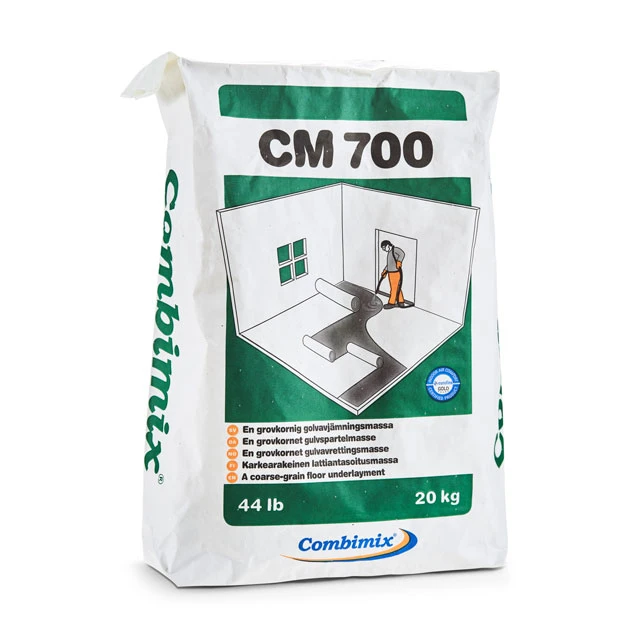CM 700 Coarse is a pumpable, self-levelling underlayment. The product can be delivered with the addition of fibrers.
The CM 700 is suitable for new construction and renovation. The product is intended for indoor use on substrates of concrete, lightweight concrete, stone and ceramic tiles.
Documents
-
Combimix_CM700_DoP_EN.pdf
-
Combimix_CM700_EPD.pdf
-
Combimix Indoor Air Comfort Gold Verified 2.pdf
-
Combimix_CM700_PDS_EN.pdf
Specifications
| Technical data | |
|---|---|
| Environment | inomhus |
| Substrate | keramik-klinker, betong, lattbetong, lattmassa, sten, varmegolv, fribarande-underlag |
| Slope construction | ja, nej |
| Leveling layer 1 | 5–70 mm |
| Leveling layer 2 | 6–20 mm light- weight concrete |
| Grain size | < 2 mm |
| Material consumption | 1.7 kg/m²/mm |
| Water demand | 5–40 mm: 3,6 l/20 kg, 40–70 mm: 3,2 l/20 kg |
| Flowability | max 135 mm, max 125 mm |
| Working temperature | 10–25 °C |
| Mixing time | 3 min |
| Workable | 10–25 min |
| Drying time category | normaltorkande |
| Walkable | 1–3 hrs |
| Coatable (tiles) | 12 hrs |
| Carpet applicable | 10 mm/week |
| Water damage resistant | yes |
| Surface tensile strength 28 days (ground loaded surface) | 1.0 MPa |
| Free shrinkage | 0.03–0.05 % |
| TVOC 28 days | 39 μg/(m² h) |
| Final surface | klinker, limmade-plastmattor, loslagt-tragolv, tatskikt |
Usage
Pre Treatment
The substrate should be clean and free of dust, cement skin, grease and other impurities that can prevent adhesion. Adhesion and surface strength of the substrate should be no less than 0.5 MPa. Always prime the underlying substrate with PP 600 and allow to dry before pouring. In terms of the primer forming a film and the curing of the self-leveling, the temperature of the substrate must not fall below 10 °C. For best results, the ambient temperature in the work area should be between 10 and 25 °C. At higher or lower temperatures, the time for curing will shorten or extend. With the risk for cracks due to shrinkage or settings in the subfloor, a concrete surface should not be leveled within the first 28 days after casting. As a recommendation the RH in the concrete should have reached RH 95 % as the upper limit for pouring the CM 700. Use the Combimix form foam for edging. In order to avoid drainage pipes from getting clogged, always make sure the drains are properly sealed before pouring.
Mixing
Mix the dry powder with max 3.6 liters of water (max 18 %) per 20 kg bag for application thickness 5–40 mm and with max 3,2 liters of water (max 16 %) per 20 kg bag for application thickness 40–70 mm. Mix with a drilling machine and a whisk, or a mixing pump intended for this purpose. The correct water mixture can be tested using a slump test with a cylinder with Ø 30 mm and a height of 50 mm on 300 x 300 mm plexiglas plate. With the correct water mixture, the spread should be max 135 mm for application thickness 5–40 mm and max 125 mm for application thickness 40–70 mm. The slump test also checks that the material is well blended and that there is no separation.
Application
The mixed material is applied by hand, or pumped out onto the substrate in lengths. Each new ribbon is added to the old one as soon as possible so that the material can blend together and create an even surface. The width of the ribbons can be adjusted to the capacity of the mixing pump and the thickness of the covering. The material requires a light treatment with a toothed trowel to provide maximum smoothness.
Post Treatment
You can easily shape or cut the semi hardened self-leveling underlayment material before it fully dries. Always make sure that the material is sufficiently dry before it will be covered by a carpet or a foilsystem. The guided time for dehydration down to RH 85 % of the product is 10 mm per week. The guiding value assumes a curing temperature of approximately 20 °C, 50 % RH and proper air flow. Newly produced surfaces must be protected against wind, sun and rain.
Storage Packaging
Store in a dry environment, on an unopened plastic-coated pallet. Paper packaging: Shelf life is 6 months in unopened original packaging from the date of production. Plastic packaging: Shelf life is 9 months in unopened original packaging from the date of production. The date of production is indicated on the packaging. The product is supplied in 20 kg bags, in big bags and in bulk.
Residual Products Protection Instructions
Paper packaging: Empty packaging is sorted as residual waste. Plastic packaging: Recycle empty and cleaned bags. Any remaining, dry powder that has been stored properly can be used again. Hardened material should be disposed of as construction waste. Do not wash the product into the sewage system. The cement in the product has a reduced level of chromate. Follow regulations in each respective country.

Packaging
| 70003 | 1000kg |
| 70005 | 20kg |
| 70009 | bulk |




